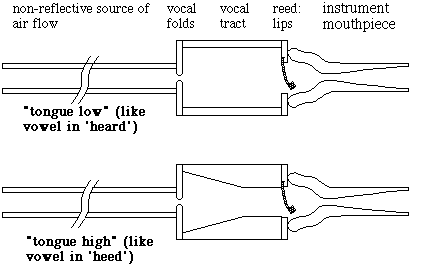Sound files from the instrument/lip-reed/vocal tract project
This research project is mainly the result of work by Alex Tarnopolsky,
in a project in collaboration with Neville Fletcher,
Lloyd
Hollenberg, John Smith
and Joe Wolfe.
For some background about the instrument in which the vocal
tract has the most spectracular coupling between vocal tract
and instrument, see our didjeridu site.
Phyl's files. These are sound files of Phyl (Plyl
stands for Physicsts' Lips). Phyl is our favourite artificial
player: she has a simple cantilever spring as a lip--so she
is more easily modelled by physicists. However, this introduces
a lot of turbulent air noise around the edge of the valve--Phyl
has a rather breathy sound. We have therefore filtered these
files with a low pass filter (unfiltered files are below).
Here she is playing a series of didjeridus of different lengths,
and then a trombone whose length is successively reduced using
the slide. Note the changes in pitch produced only by changing
the tongue height. There are also clear changes in timbre.

In each of the following two sound files, the sounds come
in successive pairs: the first sound is produced with a vocal
tract representing the 'low tongue' embouchure (roughly corresponding
to the vowel in the English word 'heard'). In the second of
each pair, the sound is made using a vocal tract corresponding
to the 'high tongue' embouchure (roughly corresponding to
the vowel in the English word 'heed'.) So what you hear is
Phyl playing 'heard', 'hid' (change to new note), heard',
'hid' (change to new note) etc.
Lloyd's files. A stroboscopic movie of Lloyd
Hollenberg's lips playing the didjeridu (1.3Mbyte).
Al's files. Al stands for Artificial Lips) Al has
water-filled latex lips. This is a sound file of Al playing
a cylindrical didjeridu while the resonances of his vocal
tract are smoothly varied by changing the position of an internal
discontinuity. Note the changes in pitch as well as the changes
in timbre.
 Al plays the didjeridu. Al plays the didjeridu.
More detailed information on didjeridu acoustics
(reproduced with kind permission of the editors).
- Tarnopolsky, A, Fletcher, N. Hollenberg, L., Lange, B., Smith, J.
and Wolfe, J. (2005) "The
vocal tract and the sound of a didgeridoo", Nature, 436,
39. (A short report.)
- Tarnopolsky, A, Fletcher, N. Hollenberg, L., Lange, B., Smith, J.
and Wolfe, J. (2006)"Vocal
tract resonances and the sound of the Australian didjeridu (yidaki)
I: Experiment", J. Acoust. Soc. America , 119, 1194-1204.
- Fletcher, N., Hollenberg, L., Smith, J., Tarnopolsky, A. and Wolfe,
J. (2006) "Vocal
tract resonances and the sound of the Australian didjeridu (yidaki)
II: Theory", J. Acoust. Soc. America, 119, 1205-1213.
(These papers have supporting web
pages, with sound files, spectra and animations.)
- Smith, J., Rey, G., Dickens. P., Fletcher, N. Hollenberg, L., and Wolfe, J. (2007) "Vocal tract resonances and the sound of the Australian didjeridu (yidaki): III. Determinants to playing quality", J. Acoust. Soc. America, 121, 547-558.
- Wolfe, J., Tarnopolsky, A.Z., Fletcher, N.H., Hollenberg, L.C.L.
and Smith, J. (2003) "Some effects of the player's vocal tract and
tongue on wind instrument sound". Proc. Stockholm Music Acoustics
Conference (SMAC 03), (R. Bresin, ed) Stockholm, Sweden. 307-310.
- Fletcher, N., Hollenberg, L., Smith, J. and Wolfe, J. (2001) "The
didjeridu and the vocal tract" Proc. International Symposium
on Musical Acoustics, Perugia. D.Bonsi, D.Gonzalez, D.Stanzial, eds, pp 87-90.
- Hollenberg, L. (2000) "The didjeridu: Lip motion and low frequency
harmonic generation" Aust. J. Phys. 53, pp 835-850.
- Fletcher, N.H. (1996) "The
didjeridu (didgeridoo)" Acoustics Australia, 24,
pp 11-15.
- Wolfe, J. and Smith, J. (2008) "Acoustical coupling between lip valves and vocal folds", Acoustics Australia, 36, 23-27.
- Fletcher, N., Hollenberg, L., Smith, J. and Wolfe, J.
(2001) "The didjeridu and the
vocal tract" Proc. International Symposium on Musical
Acoustics, Perugia. D.Bonsi, D.Gonzalez, D.Stanzial,
eds, pp 87-90. (.pdf file)
- Hollenberg, L. (2000) "The didjeridu: Lip motion and low
frequency harmonic generation" Aust. J. Phys. 53,
pp 835-850.
- Fletcher, N.H. (1996) "The didjeridu (didgeridoo)"
Acoustics Australia, 24, pp 11-15.(.html link)
- See also our didjeridu site.
Alex Tarnopolsky
[1].Neville Fletcher[2],
Lloyd
Hollenberg [3], John Smith
[1] and Joe Wolfe
[1].
[1] The University of
New South Wales, [2]The
Australian National University and [3] The
University of Melbourne.
This project is supported by the Australian
Research Council. |


 File of Phyl playing didjeridus (unfiltered).
File of Phyl playing didjeridus (unfiltered).
 File of Phyl playing the trombone (unfiltered).
File of Phyl playing the trombone (unfiltered).